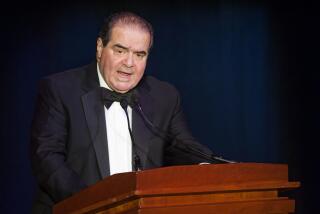How to Stop Mass Public Shootings
- Share via
It is too bad Barbra Streisand won’t debate Charlton Heston over the meaning of the 2nd Amendment. Yet, as entertaining as that debate would be, the more important question is: Would gun control have prevented the horrific shootings discussed in her movie based on Colin Ferguson’s rampage, which took six lives on the Long Island Railroad in 1993?
In Streisand’s movie, the solution is clear: more regulations of guns. However, what might appear to be the most obvious policy may actually cost lives. When gun-control laws are passed, it is law-abiding citizens, not would-be criminals, who adhere to them. Police officers or armed guards cannot be stationed everywhere, so gun-control laws risk creating situations in which the good guys cannot defend themselves.
Other countries have followed a different solution. Twenty or so years ago in Israel, there were many instances of terrorists pulling out machine guns and firing away at civilians in public. However, with expanded concealed-handgun use by Israeli citizens, terrorists soon found ordinary people pulling pistols on them. Suffice it to say, terrorists in Israel no longer engage in such public shootings.
The one recent shooting of schoolchildren in the Middle East further illustrates these points. On March 13, 1997, seven Israeli girls were shot to death by a Jordanian soldier while they visited Jordan’s so-called Island of Peace. The Times reported that the Israelis had “complied with Jordanian requests to leave their weapons behind when they entered the border enclave. Otherwise, they might have been able to stop the shooting, several parents said.”
Hardly mentioned in the massive news coverage of the school-related shootings during the past year is how they ended. Two of the four shootings were stopped by a citizen displaying a gun. In the October 1997 shooting spree at a high school in Pearl, Miss., which left two students dead, an assistant principal retrieved a gun from his car and physically immobilized the shooter while waiting for the police.
More recently, the school-related shooting in Edinboro, Pa., which left one teacher dead, was stopped only after a bystander pointed a shotgun at the shooter when he started to reload his gun. The police did not arrive for another 10 minutes.
Who knows how many lives were saved by these prompt responses?
Anecdotal stories are not sufficient to resolve this debate. Together with my colleague William Landes, I have compiled data on all the multiple-victim public shootings occurring in the U.S. from 1977 to 1995. Included were incidents where at least two people were killed or injured in a public place; to focus on the type of shooting seen in the Ferguson rampage, we excluded gang wars or shootings that were the byproduct of another crime, such as robbery. The U.S. averaged 21 such shootings annually, with an average of 1.8 people killed and 2.7 wounded in each one.
We examined a range of different gun laws, such as waiting periods as well as methods of deterrence, such as the death penalty. However, only one policy was found to reduce deaths and injuries from these shootings: allowing law-abiding citizens to carry concealed handguns.
The effect of “shall-issue” concealed handgun laws, which give adults the right to carry concealed handguns if they do not have a criminal record or a history of significant mental illness, was dramatic. Thirty-one states now have such laws. When states passed them during the 19 years we studied, the number of multiple-victim public shootings declined by 84%. Deaths from these shootings plummeted on average by 90%, injuries by 82%. Higher arrest rates and increased use of the death penalty slightly reduced the incidence of these events, but we could not conclusively determine such an effect.
Unfortunately, much of the public policy debate is driven by lopsided coverage of gun use. Horrific events like the Colin Ferguson shooting receive massive news coverage, as they should, but the 2.5 million times each year that people use guns defensively--including cases in which public shootings are stopped before they happen--are ignored.
Concealed handgun laws also deter other crimes from occurring. I recently analyzed the FBI’s crime data for all 3,054 counties in the United States from 1977 to 1994. The more people who obtained permits, the more violent crime declined. After concealed handgun laws have been in effect for 5 years, murders declined by at least 15%, rapes by 9% and robberies by 11%. Permit holders were found to be extremely law-abiding, and data on accidental deaths and suicides indicate that there were no increases.
The possibility of a law-abiding citizen carrying a concealed handgun is apparently enough to convince many would-be killers that they will not be successful. Without permitting law-abiding citizens the right to carry guns, we risk leaving victims as sitting ducks.
More to Read
Get the L.A. Times Politics newsletter
Deeply reported insights into legislation, politics and policy from Sacramento, Washington and beyond. In your inbox three times per week.
You may occasionally receive promotional content from the Los Angeles Times.










